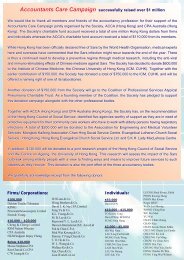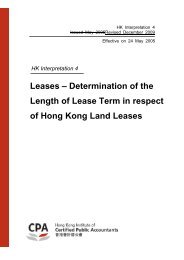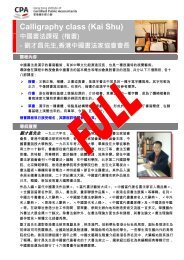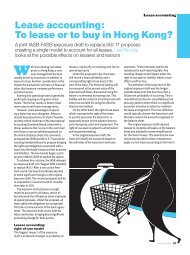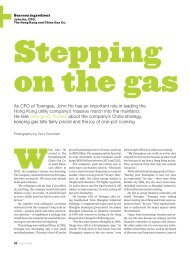Download - Hong Kong Institute of Certified Public Accountants
Download - Hong Kong Institute of Certified Public Accountants
Download - Hong Kong Institute of Certified Public Accountants
You also want an ePaper? Increase the reach of your titles
YUMPU automatically turns print PDFs into web optimized ePapers that Google loves.
Fair value<br />
How your property valuations can<br />
be fully compliant with HKFRS 13<br />
Property valuations are commonly required for financial reporting<br />
purposes. Gary Stevenson explains how they need to meet the<br />
upcoming standard on fair value measurement<br />
HKFRS 13 Fair Value<br />
Measurement provides<br />
a single comprehensive<br />
source <strong>of</strong> guidance on<br />
how fair value is measured for financial<br />
reporting purposes. The standard is applied<br />
prospectively for annual periods beginning<br />
on or after 1 January 2013 and earlier<br />
application is permitted.<br />
Property valuations are commonly<br />
required for financial reporting purposes, for<br />
example, for investment property, property<br />
acquired through a business combination<br />
or property being tested for impairment.<br />
Entities <strong>of</strong>ten use external valuers to value<br />
their property interests. Nonetheless,<br />
management is still responsible for the<br />
fair value measurements included in the<br />
financial statements. They therefore need<br />
to assess whether the valuation techniques<br />
and assumptions used by external valuers<br />
comply with HKFRS 13. This will require an<br />
understanding <strong>of</strong> the main requirements <strong>of</strong><br />
the standard relevant to property valuations.<br />
Definition <strong>of</strong> fair value under HKFRS 13 and<br />
International Valuation Standards<br />
Fair value under HKFRS 13 is a different<br />
concept to fair value as defined in<br />
International Valuation Standards.<br />
Rather, the concept <strong>of</strong> market value as<br />
defined in IVS will generally meet the<br />
fair value measurement requirement<br />
under HKFRS 13 subject to certain specific<br />
assumptions which are required by the<br />
standard. Management should be aware<br />
<strong>of</strong> this difference in concepts when<br />
communicating with external valuers in<br />
46 December 2012<br />
order to ensure that property valuations are<br />
suitable for financial reporting purposes.<br />
Which characteristics <strong>of</strong> the property<br />
should be taken into account?<br />
Fair value should reflect those characteristics<br />
<strong>of</strong> an asset that would influence the pricing<br />
decisions <strong>of</strong> market participants. These<br />
may include the condition and location <strong>of</strong> a<br />
property and any restrictions on its use or<br />
sale. Only restrictions that are specific to the<br />
property and that would be transferred to<br />
market participants with the property are<br />
incorporated in fair value, for example legal<br />
rights <strong>of</strong> use. The characteristics taken into<br />
account reflect the property as it currently<br />
exists, even if they are not associated with its<br />
highest and best use.<br />
Highest and best use<br />
Fair value takes into account the highest<br />
and best use <strong>of</strong> a nonfinancial asset such<br />
as property. That is the way a market<br />
participant would use the property to<br />
maximize its value or the value <strong>of</strong> the group<br />
<strong>of</strong> assets and liabilities, for example a<br />
business within which it would be used.<br />
HKFRS 13 presumes that an entity’s<br />
current use <strong>of</strong> a nonfinancial asset is its<br />
highest and best use unless market or other<br />
factors suggest otherwise. Management does<br />
not need to consider all possible alternative<br />
uses <strong>of</strong> the property if there is no evidence<br />
to suggest that the current use is not its<br />
highest and best use. The highest and best<br />
use may differ, for example where land held<br />
for industrial purposes has potential for<br />
redevelopment for commercial use.<br />
The highest and best use <strong>of</strong> the property<br />
should be physically possible, legally<br />
permissible and financially feasible. The use<br />
<strong>of</strong> a property does not need to be legal at the<br />
measurement date but should not be legally<br />
prohibited. The illustrative examples to<br />
HKFRS 13 show how land can be zoned for a<br />
particular use at the measurement date but<br />
how a fair value measurement could assume<br />
a different zoning if market participants<br />
would do so. Fair value should incorporate<br />
the costs <strong>of</strong> obtaining any necessary<br />
approvals for changing the use <strong>of</strong> the<br />
property, including the risk that they might<br />
not be granted and the costs <strong>of</strong> converting<br />
the property to the alternative use.<br />
The valuation premise<br />
The highest and best use <strong>of</strong> a nonfinancial<br />
asset determines how its fair value should<br />
be measured. This will either be on a stand<br />
alone basis or in combination with other<br />
assets and liabilities, for example a business.<br />
HKFRS 13 sets out principles for<br />
determining the assets and liabilities to be<br />
included in the group. Where the highest and<br />
best use <strong>of</strong> the property is in combination<br />
with other assets or with other assets and<br />
liabilities, the fair value measurement<br />
assumes that the buyer already holds (or is<br />
able to obtain) the complementary assets and<br />
associated liabilities and will use the property<br />
in a similar way.<br />
The property’s use in an asset group may<br />
be reflected in fair value by adjusting the<br />
stand alone value or adjusting the valuation<br />
assumptions used. In limited situations, an<br />
entity might measure the property at an



